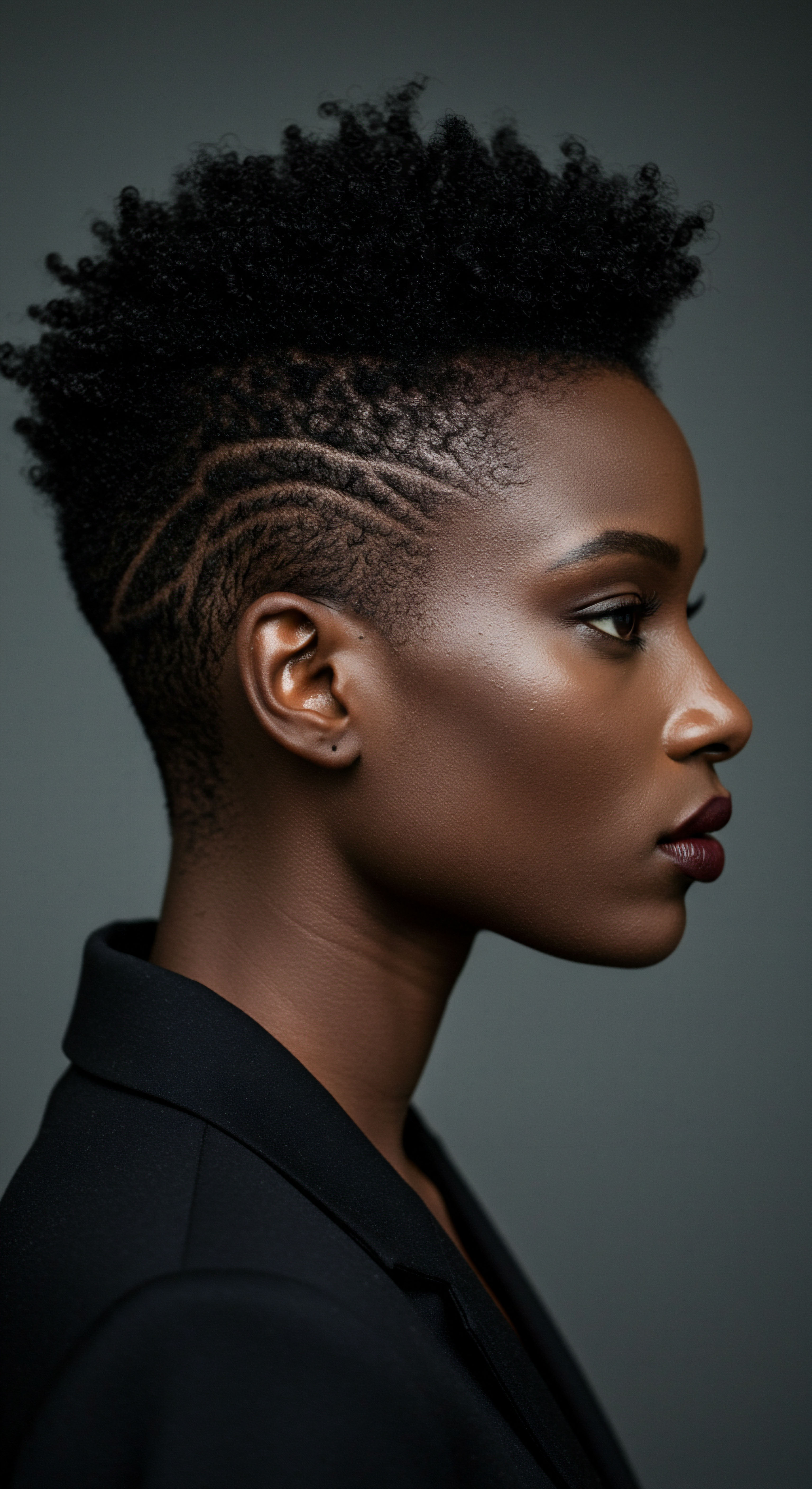
Roots
The whisper of history often carries profound truths, particularly when it settles upon something as personal and deeply rooted as hair. In the vibrant, complex world of 18th-century New Orleans, a quiet revolution of identity unfolded on the heads of free women of color. Their elaborate coiffures, sculpted with artistry and adorned with precious elements, were not merely styles; they were declarations. These styles spoke of heritage, of prosperity, and of a beauty that defied the rigid social structures of the colonial era.
The Spanish colonial authorities, witnessing this undeniable display of self-possession and allure, perceived it as a challenge to the established order. This perceived threat led to the implementation of the Tignon Laws in 1786, an attempt to diminish the visible social standing of these women by mandating head coverings. Yet, the spirit of those women, their connection to their strands, would transform an act of subjugation into a testament to resilience.
New Orleans, a city built on a foundation of diverse cultures, presented a unique social landscape. French, Spanish, African, and Indigenous influences converged, creating a society unlike any other in the Americas. Within this melting pot, a distinct class of Free People of Color, or gens de couleur libres, emerged. Many of these women, often descendants of relationships between European men and African women, had achieved a remarkable degree of economic independence and social standing.
They owned property, ran businesses, and cultivated a sophisticated culture. Their hair, a canvas for expression, reflected this prosperity and cultural blending. Intricate braids, gravity-defying twists, and artfully arranged coils, frequently embellished with jewels, feathers, and ribbons, showcased their inherent beauty and creative spirit. This visual autonomy, however, stirred discomfort among the white European elite, particularly white women, who saw their own social and marital prospects challenged by the undeniable appeal of these women.
In 18th-century New Orleans, the vibrant hair artistry of free women of color became a powerful visual statement of their social and economic standing, perceived as a challenge to colonial hierarchies.
The Tignon Laws, enacted by Governor Esteban Rodriguez Miró, were sumptuary laws. Such regulations, historically common across various cultures and periods, aimed to control consumption and visible displays of wealth or status. For instance, across colonial Spanish America, sumptuary laws frequently sought to regulate the dress of different castes, reflecting a deep current of hostility to the embrace of dominant European culture by subalterns. In New Orleans, the specific aim of the Tignon Laws was to visibly mark women of African descent, whether free or enslaved, as belonging to a subordinate class.
The decree mandated that they cover their hair with a tignon, a scarf or handkerchief. The intent was clear ❉ to obscure their beauty, to enforce a visual hierarchy, and to diminish their perceived attractiveness and social competition. This act was a direct assault on their personal autonomy and a subtle attempt to erase their distinct cultural expression, which had become a source of both admiration and envy.
The concept of hair as a marker of identity and status has deep roots in many African cultures. Before forced displacement to the Americas, hair was often a signifier of age, marital status, religious affiliation, wealth, and tribal identity. Elaborate hairstyles conveyed stories and communicated social standing. When Africans were forcibly brought to the Americas, many aspects of their cultural identity, including hair practices, were suppressed.
Yet, in places like New Orleans, where a degree of cultural retention and blending was possible, these traditions persisted and adapted. The opulent hairstyles of the free women of color were a continuation of this heritage, a defiant act of self-definition in a society that sought to strip them of their personhood. The Tignon Laws, then, were not simply about head coverings; they represented a systemic effort to dismantle a visible symbol of cultural pride and individual freedom.

Ritual
Stepping into the daily rhythm of life under the Tignon Laws meant confronting a new ritual, one imposed from above yet transformed from within. For the free women of color in New Orleans, the mandate to cover their hair could have been a crushing blow to their spirit, a daily reminder of their prescribed lower status. Yet, what unfolded was a testament to human ingenuity and an enduring commitment to self-expression.
The tignon, initially a symbol of oppression, became a canvas for quiet defiance, a new form of sartorial language that spoke volumes without uttering a word. This section delves into the practicalities of the Tignon Laws and how these women, with grace and unyielding spirit, subverted their intended purpose.
The law stipulated that women of African descent, whether free or enslaved, must wear a tignon in public. This head covering was intended to be plain, a visual signifier of their subordinate position. The colonial authorities aimed to make these women less “enticing” to white men and to differentiate them from white women. The daily act of preparing oneself, once a moment of personal adornment and celebration of one’s natural beauty, now included the obligatory wrapping of the head.
However, the women of New Orleans possessed a profound understanding of aesthetics and a fierce dedication to their identity. They did not simply comply; they creatively adapted.
Through artful styling and rich fabrics, women transformed the tignon from a symbol of subjugation into a statement of cultural pride and resistance.
Instead of drab handkerchiefs, they sought out the most luxurious and vibrant fabrics available. Silks, satins, and fine muslins in brilliant hues of red, yellow, and blue became their preferred materials. They tied these coverings with elaborate knots and sculptural arrangements that, far from hiding their hair, often drew more attention to their heads.
Feathers, jewels, and intricate brooches, previously used to adorn their hairstyles, were now incorporated into the tignons themselves, elevating the simple scarf into a striking fashion statement. This was not mere compliance; it was a powerful act of Aesthetic Protest, a declaration of pride and a positive marker of a culture unique unto itself.

How Did These Women Acquire Such Materials?
The ability to procure such fine materials speaks to the economic standing of many free women of color. As entrepreneurs, artisans, and property owners, they had access to resources that allowed them to transcend the intended simplicity of the tignon. They were seamstresses, milliners, and merchants, participating actively in the city’s economy. Their economic independence provided a foundation for this sartorial rebellion.
This resourcefulness echoes the broader history of dress as a form of resistance among enslaved and freed women in the Americas, where clothing often became a strategy of subversion, of making “non-people” look like people. The daily ritual of dressing, therefore, became a powerful act of reclaiming agency within an oppressive system.
The impact of this creative resistance extended beyond personal expression. The visually striking tignons became a new form of social currency, drawing admiration and cementing the unique style of New Orleans’ free women of color. What was designed to degrade instead highlighted their creativity and sophistication. This phenomenon offers a compelling counter-narrative to the oppressive intent of the laws.
It showcases how individuals, even under duress, can find avenues for self-assertion and cultural continuity. The Tignon Laws, intended to diminish, inadvertently contributed to the birth of a distinct New Orleans aesthetic, one that continues to influence fashion and cultural identity today.

Relay
To truly grasp the reach of the Tignon Laws, we must move beyond the immediate visual impact and delve into the intricate interplay of power, identity, and the enduring human spirit. The colonial decree, while short-lived in its official enforcement after the Louisiana Purchase, cast a long shadow, its ripples extending through generations and finding echoes in contemporary discussions surrounding Black women’s hair. This section endeavors to illuminate the profound, multi-dimensional consequences of these laws, drawing on scholarly perspectives and real-world data to reveal the subtle yet potent ways they shaped the lives and legacies of Black women.
The Tignon Laws were a prime example of sumptuary legislation weaponized against a specific racial and social group. Such laws, as Rebecca Earle discusses in “Race, Clothing and Identity ❉ Sumptuary Laws in Colonial Spanish America,” consistently reflected a deep-seated hostility towards subaltern groups adopting dominant cultural expressions. In New Orleans, this hostility was directed at the perceived social and economic ascension of free women of color. Historian Virginia M.
Gould notes that Governor Miró aimed to control women who “had become too light skinned or who dressed too elegantly, or who competed too freely with white women for status and thus threatened the social order.” This reveals a deep-seated anxiety among the white elite regarding racial blurring and challenges to their established hierarchy. The laws were not simply about modesty; they were about maintaining a fragile racial and social order through visual segregation.

What Was the Psychological Burden of Such Laws?
Beyond the visible act of covering, the Tignon Laws imposed a significant Psychological Burden. Being compelled to conceal a part of one’s identity, especially one as culturally significant as hair, can contribute to feelings of dehumanization and diminished self-worth. Änna C. Pettway and Pensiri Kongkaw, in their work “EXISTINGWHILEBLACK ❉ THE PSYCHOLOGICAL BURDEN OF ANTI-BLACK RACISM IN THE LIBERAL ARTS,” observe that the appearance of Black bodies and Black hair has historically been penalized, and laws like the Tignon Laws were enacted to criminalize Black hair.
This constant policing of appearance, rooted in white standards, fosters a climate of anxiety and self-consciousness. While the women’s creative resistance was powerful, it emerged from a context of attempted suppression. The internal struggle to maintain dignity and self-acceptance in the face of such external pressure remains a critical, though often invisible, impact.
The legacy of the Tignon Laws can be traced through the continuing societal policing of Black hair. Even today, despite advancements, Black women face discrimination in professional and educational settings based on their natural hairstyles. A 2020 study by Duke University found that Black women with natural hairstyles were perceived as less professional, less competent, and less likely to be recommended for job interviews than candidates with straight hair.
This suggests that the underlying biases that fueled the Tignon Laws—the association of natural Black hair with a perceived lack of professionalism or lower status—persist. This modern phenomenon, while not legally mandated head coverings, represents a continuation of the historical attempt to enforce Eurocentric beauty standards and control Black women’s bodies and economic mobility.
Consider the following comparison of historical and contemporary hair discrimination:
| Aspect Origin |
| Tignon Laws (1786, New Orleans) Spanish colonial decree |
| Contemporary Hair Discrimination (21st Century) Unwritten social norms, workplace policies, school dress codes |
| Aspect Aim |
| Tignon Laws (1786, New Orleans) Visually mark women of African descent as subordinate, curb perceived social/economic threat, reduce attractiveness to white men |
| Contemporary Hair Discrimination (21st Century) Enforce Eurocentric beauty/professionalism standards, maintain racial hierarchy, limit economic/social mobility |
| Aspect Method |
| Tignon Laws (1786, New Orleans) Mandatory head coverings (tignons) |
| Contemporary Hair Discrimination (21st Century) Bans on natural hairstyles (afros, braids, locs, twists), implicit bias in hiring/promotion |
| Aspect Impact on Identity |
| Tignon Laws (1786, New Orleans) Attempt to degrade and erase cultural expression, but often subverted into statements of defiance |
| Contemporary Hair Discrimination (21st Century) Causes anxiety, impacts self-esteem, forces choice between identity and economic advancement |
| Aspect The persistent thread of control over Black women's appearance runs from colonial sumptuary laws to modern biases. |
This historical context is crucial for understanding the broader politics of Black hair. As Sylviane Ngandu-Kalenga Greensword argues in “Historicizing Black Hair Politics,” Black hair has always been political, used not only to exert oppression but also to resist alienation. The Tignon Laws were an early, explicit manifestation of this struggle.
The act of turning the tignon into a fashion statement was not a mere stylistic choice; it was a declaration of self-ownership and cultural pride. This deep-seated connection between hair, identity, and resistance continues to this day, making the study of the Tignon Laws a vital lens through which to comprehend the ongoing fight for hair freedom and racial justice.
- Cultural Continuity ❉ The Tignon Laws, while attempting to suppress African cultural expressions, inadvertently solidified the headwrap as a powerful symbol of identity and resistance for generations.
- Economic Implications ❉ The laws sought to limit the social and economic mobility of free women of color by diminishing their perceived status and attractiveness, thereby hindering their ability to secure favorable unions or business opportunities.
- Psychological Resilience ❉ Despite the oppressive intent, the women’s ability to transform the tignon into an object of beauty showcased immense psychological resilience and a refusal to internalize imposed inferiority.

Reflection
The story of the Tignon Laws, unfolding in the vibrant streets of colonial New Orleans, is more than a historical footnote. It is a quiet echo of the enduring power of personal expression, a testament to the unyielding spirit that finds beauty even in the face of adversity. These laws, born of fear and control, aimed to diminish. Yet, in the hands of the women they targeted, the simple tignon became a symbol of defiance, a canvas for creativity, and a lasting marker of cultural pride.
It reminds us that our hair, in all its varied forms, is never just a collection of strands; it is a profound extension of who we are, a chronicle of our heritage, and a silent, yet powerful, declaration to the world. The journey of textured hair, from ancient traditions to modern self-acceptance, continues to be one of quiet strength and radiant authenticity.

References
- Buckridge, Steeve. The Language of Dress ❉ From Slavery to Freedom Among Jamaican Colonised Women, 1790-1890. University of the West Indies Press, 2016.
- Earle, Rebecca. “Race, Clothing and Identity ❉ Sumptuary Laws in Colonial Spanish America.” In The Right to Dress ❉ Sumptuary Laws in a Global Perspective, c. 1200-1800, edited by Ulinka Rublack and Giorgio Riello. Cambridge University Press, 2019.
- Gould, Virginia M. The Devil’s Lane ❉ Sex & Race in the Early South. Oxford University Press, 2002.
- Greensword, Sylviane Ngandu-Kalenga. “Historicizing Black Hair Politics ❉ A Framework for Contextualizing Race Politics.” Sociology Compass, vol. 18, no. 1, 2024.
- Pettway, Änna C. and Pensiri Kongkaw. “EXISTINGWHILEBLACK ❉ THE PSYCHOLOGICAL BURDEN OF ANTI-BLACK RACISM IN THE LIBERAL ARTS.” Journal of African American Women and Girls in Higher Education, vol. 1, no. 1, 2020.
- Robinson, Dena Elizabeth, and Tyra Robinson. “Between a Loc and a Hard Place ❉ A Socio-Historical, Legal, and Intersectional Analysis of Hair Discrimination and Title VII.” Journal of Race, Religion, Gender and Class, vol. 11, no. 1, 2021.
- Winters, Ze. The Mulatta Concubine ❉ Terror, Intimacy, Freedom, and Desire in the Black Transatlantic. University of Georgia Press, 2015.